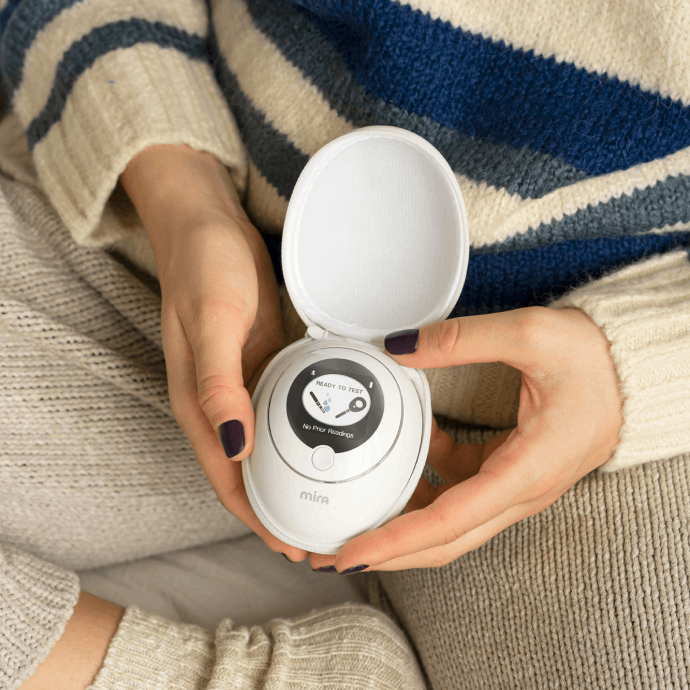Can You Get Pregnant from Pre-Cum?

Yes, You Can Get Pregnant from Pre-Cum
You may have heard that pre-cum doesn’t contain sperm and can’t lead to pregnancy. While it’s technically true that pre-cum itself does not contain sperm, it can still be contaminated with sperm from previous ejaculations.
It only takes one single sperm cell to fertilize an egg — so even if your partner ‘pulls out’ before ejaculation, you can still get pregnant from pre-cum. This is why the ‘pull-out’ or ‘withdrawal method’ is not a reliable form of birth control.
Read on to learn what pre-cum is, why it sometimes contains sperm, and how you can manage your pregnancy risk.
What Is Pre-Cum?
Precum or “pre-ejaculate fluid” is the lubricating fluid that comes out of a penis during sexual arousal. It is produced by the Cowper’s gland and released from the urethra.
The purpose of pre-cum is to neutralize acidity in the urethra and provide lubrication during sex. This helps create an environment where sperm can survive and move throughout the female reproductive tract.

What is the Difference Between Pre-Cum and Semen?
Pre-cum is released anytime during sexual arousal, while semen is only released during ejaculation. Unlike pre-cum, which is produced by the Cowper’s gland, semen is produced by the seminal vesicles and the prostate gland. Semen also contains an average of 20 to 150 million sperm cells per milliliter, while pre-cum itself does not contain sperm.
Does Pre-Cum Have Sperm?
No. In its pure form, pre-cum does not contain sperm.
However, pre-cum may contain sperm if leftover semen from a previous ejaculation is still present in the urethra. When this happens, it can mix with pre-cum at the next time of arousal; making pregnancy possible. Urinating before and after sex can help flush out any leftover sperm in the urethra. However, it’s impossible to know with certainty that pre-cum is ‘pure’ and not contaminated.
Here’s what the research suggests:
- A 2010 research study found the presence of motile sperm in 10 out of 27 pre-ejaculatory samples.
- A 2016 research study found the presence of mobile sperm in 7 out of 42 pre-ejaculatory samples.
- A 2024 research study found the presence of sperm in concentrations of ‘clinical pregnancy risk’ in 7 out of 70 pre-ejaculatory samples.
Even though the likelihood of having sperm in pre-cum is relatively low, it still only takes one single sperm cell to fertilize an egg. This is why pregnancy is always possible at any point during unprotected sex.
What Are the Chances of Getting Pregnant from Pre-Cum?
To better understand your chances of getting pregnant from pre-cum, you have to assume that sperm may be present at any time during unprotected sex.
The following table lists several scenarios ranked in order from the lowest to highest likelihood of pregnancy.
| Chances of Pre-Cum Leading to Pregnancy | ||
| Scenario | Likelihood of Pregnancy | Explanation |
| Having unprotected sex after a vasectomy | Extremely low | The chance of pregnancy is 1 in 2,000. Backup contraception is recommended until a semen analysis confirms semen is sterile. |
| Having sex with an IUD | Extremely low | IUDs are over 99% effective at preventing pregnancy. Copper IUDs can also be used as emergency contraception. |
| Having sex while taking oral contraceptive pills. | Very low | Oral contraceptives are 91% effective with typical use and 99% effective with perfect use. |
| Having sex with a condom | Very low | Condoms are 82% effective with typical use and 98% effective with perfect use. |
| Having unprotected sex during menstruation | Low but possible | The risk of pregnancy during menstruation is highest in cases where ovulation occurs early in a short cycle. |
| Using the withdrawal method | Moderate to high | Risk varies. The general consensus is that the withdrawal method is around 82% effective at preventing pregnancy with typical use and 96% effective with perfect use. |
| Having unprotected sex during the fertile window | High | The chance of pregnancy is highest during the fertile window. Research suggests the average chance of conception is 33% two days before ovulation, 42% one day before ovulation, and 20% the day of ovulation. |
The Withdrawal Method Explained
How the Withdrawal Method Works
The withdrawal method — also known as the “pull-out method” or “coitus interruptus” — is when the penis is taken out of the vagina before ejaculation. The goal is to prevent semen from entering the vagina to prevent pregnancy.
While the vagina (in theory) is not exposed to semen, it is still exposed to pre-cum which may still contain sperm. This is why the withdrawal method is not a reliable way to prevent pregnancy.
How Effective Is the Withdrawal Method?
The withdrawal method is not very effective at preventing pregnancy. Even though it’s considered to be 96% effective with perfect use, it is difficult to follow the method perfectly and some factors are out of your control.
A more realistic figure to follow is the typical use figure, which estimates the withdrawal method to be 82% effective at preventing pregnancy. This means around 20 out of every 100 couples will conceive when using the withdrawal method.
Here’s why the withdrawal method has limited effectiveness:
- Timing: pulling out at the right time is difficult and it’s common to pull out too late.
- Lack of self-control: the urge to continue through ejaculation can be difficult to resist.
- Pre-cum contamination with sperm: there is always the risk that pre-cum contains sperm from previous ejaculations.
If you are actively trying to avoid pregnancy, you should use a backup form of birth control when having sex.
Can You Get Pregnant from Pre-Cum If You’re Not Ovulating?
Yes. Sperm can survive inside the female reproductive tract for up to five days. So if unprotected sex occurs within the fertile window (up to five days before ovulation), it’s possible for sperm to still be present during ovulation.
If you want to avoid pregnancy but you’re not quite sure when your fertile window occurs, it’s helpful to track your cycle. Here are a few different ways you can do this:
- Tracking your cycle dates in a calendar or period tracking app (such as the Mira App)
- Tracking changes to cervical mucus
- Tracking changes to basal body temperature (BBT) with a BBT thermometer
Out of all the different cycle tracking strategies, the most accurate way to anticipate your fertile window is by monitoring your hormonal fluctuations. With the Mira Hormone Monitor and Wands, you can track E3G (a urinary metabolite of estrogen), PdG (a urinary metabolite of progesterone), and luteinizing hormone (LH). This enables you to predict your full six-day fertile window and ovulation date with lab-grade precision — all from the comfort of home.
Emergency Contraception: What to Do If You Had Unprotected Sex
If you’ve had unprotected sex and you don’t want to get pregnant, you may be able to use emergency contraception. Here are your options:
| Emergency Contraception Methods | |||
| Levonorgestrel | Ulipristal Acetate | Copper IUD | |
| Brand Name | Plan B | Ella | Paragard |
| Type of Contraception | Pill | Pill | IUD |
| Prescription required? | No | Yes | Yes. A doctor’s visit is also required for insertion. |
| Timings | Can be taken within 72 hours after unprotected sex | Can be taken up to 120 hours after unprotected sex | Must be inserted within 120 hours of unprotected sex |
| Effectiveness | Most effective when taken as soon as possible | More effective than levonorgestrel if taken after 72 hours | More effective than emergency contraception pills (but often more expensive) |
Emergency contraception works best when taken (or inserted in the case of the copper IUD) as soon as possible after unprotected sex. If you are unsure about which method is right for you, speak with your healthcare provider. They can provide you with the best guidance for your situation.
When to Take a Pregnancy Test
If you think you may be pregnant, you can take a pregnancy test no sooner than:
- The first day after a missed period or
- 12 days past ovulation (DPO)
If your periods are irregular, you should wait at least 21 days after you’ve had unprotected sex. This ensures your pregnancy test result will be accurate.
If you’re anxious about the possibility of being pregnant, it can be tempting to take a pregnancy test immediately after having unprotected sex. However, it’s important to wait and take the test at the right time.
Pregnancy tests work by measuring hCG (human chorionic gonadotropin) levels in urine. If you test too soon, your hCG levels may be too low to be detected in a pregnancy test — even if you’re pregnant. This is called a false-positive result.
If you’re unsure or confused about your results, wait a few days and then test again. You can also get a blood test at your doctor’s office to confirm pregnancy.

A little extra support from an expert can go a long way
Book an online consultation with one of our Hormone Health Coaches.
Schedule NowKey Takeaways: Pre-Cum and Pregnancy
To sum it up: yes, you can get pregnant from pre-cum.
Here’s why:
- Although pre-cum does not contain sperm, sperm can still be present if it mixes with leftover semen.
- The withdrawal method is not a reliable form of birth control. This is because pre-cum (which is secreted prior to ejaculation) may be contaminated with sperm.
If you’ve had unprotected sex and used the withdrawal method, there is a chance you could be pregnant. If you do not want to conceive, you can use emergency contraception up to five days after sex.
If you think you may be pregnant, you should wait and take a pregnancy test no sooner than the first day after a missed period or 12 days past ovulation (DPO). This gives your hCG levels enough time to rise so they can be accurately detected with a pregnancy test.
Frequently Asked Questions
What is the chance of getting pregnant from pre-cum?
The risk of getting pregnant from pre-cum depends on a number of factors, such as:
Where you are in your cycle and
Whether or not you’re using a backup method of birth control
If you are actively trying to avoid pregnancy, you should not have unprotected sex at any time. You should also not rely on the withdrawal method to prevent pregnancy, as there is always a chance of pre-cum being contaminated with sperm.
How effective is the pull-out method?
The pull-out or withdrawal method is only around 82% effective at preventing pregnancy. It is not a reliable way to avoid pregnancy.
When does pre-cum occur?
Pre-cum can be secreted anytime during sexual arousal.
Is it true that pre sperm can cause pregnancy?
Yes, it’s possible to get pregnant from pre-cum that contains sperm.
Mira’s Editorial Process
All content produced by Mira meets stringent editorial standards, ensuring excellence and accuracy in language and medical precision. Every piece undergoes thorough fact-checking and review by qualified professionals. Check out our full editorial process to learn more.










